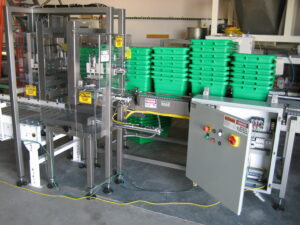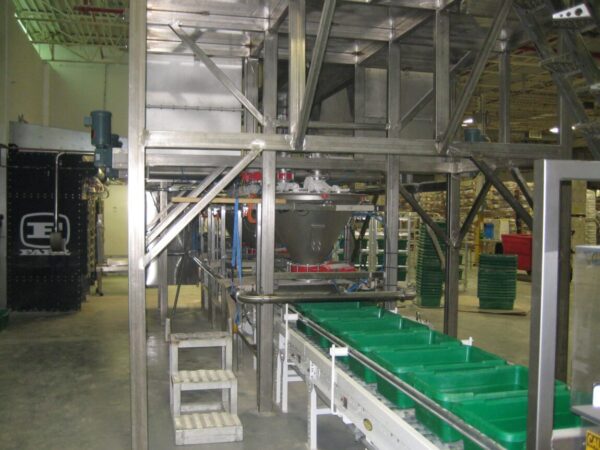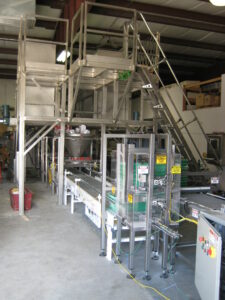Denesting Totes in Minor Batching System

Denesting totes in a minor batching system is necessary when the totes and ingredients being batched are “nested” together. What is “denesting”? Quite obviously, denesting is the term used for the separation of items which are nested together. Ingredient batching systems (micro, minor or major weighments) or material weighing systems often create batches in plastic totes that can and are often “nested” together. To run each tote through the ingredient batching system, they have to first be denested.

Opportunity
Sterling Systems & Controls, Inc. was asked to include denesting as a part of a custom-engineered minor ingredient batching system for a customer in the baking industry. Often, the ingredients for a baked good are batched into a small tote. In this specific application, the minor ingredient batching system is a fourteen (14) bin system of food-grade stainless steel construction. The bins vary in size, including six (6) 12 cubic-foot bins, two (2) 18 cubic-foot bins, two (2) 31 cubic-foot bins, and four (4) 39 cubic-foot bins. The minor system is designed to run and fill over 700 totes per 8-hour shift. That’s nearly 90 batches per hour or more than 1.45 totes per minute. The totes are “nested” together and must first be denested before the tote can be used to collect a batch in the system. Denesting totes in a minor ingredient batching system requires a special machine be adapted and added upfront in the batching system.
The minor ingredient system includes multiple scales, three (3) scale hoppers each with several ingredients being fed into them respectively. This allows multiple totes to be processed at the same time. Each tote has 1.6 cubic-foot capacity, a 15″ x 25″ opening and 8.75″ depth.

How It Works
The minor ingredient system is an ACCU-PORTION™ Automatic Ingredient Batching System that automatically prepares accurately weighed batches to increase production throughput while minimizing manual labor. In the actual operation of the minor ingredient batching system, the following procedure is used:
- The operator selects the desired formula to be batched along with the desired number of batches of that formula using the keypad on the system control panel.
- Once the operator verifies the formula requirements are correct, he places the nested tub(s) in the denesting section of the empty indexing conveyor.
- Once tubs are staged and the system is started, the system will denest each tub one at a time and index each empty tub to the scales one after the other. Tubs will not index until there are empty tubs in position to be indexed, thereby eliminating empty scaling positions and maximizing throughput (not losing any batching time). The controls will automatically start each feeder in turn.
- Each feeder has computer-controlled two-speed control (fast fill, slow dribble) for high-accuracy transfer weights.
- After the desired ingredients are discharged from the scale hoppers, the tubs will be indexed to the next scale hopper until completed, where the tubs will be indexed to the gravity conveyor or unloading position. The system will continue this sequence.
- For maximum throughput, the system simultaneously weighs into the three (3) scale hoppers – one ingredient per scale at a time. Once the tubs have completed collecting ingredients at each of the scale hoppers, the tubs are conveyed to the exit gravity conveyor.
The control system provides real-time records for each batch produced, enabling the highest standards to be maintained by ensuring a consistent product. As batches are produced, the system records the batch data to the database and can print batch reports to an office printer. The report provides each ingredient by identification along with the required and the actual formula weights. A time and date is also stamped on each report at the start and end of the batch. If an alarm condition occurs during batch processing, the system will print an alarm message, enabling a supervisor to review the performance of the operator and track problems that may occur later.
The system is controlled using an exclusive custom-engineered Sterling Systems’ Batching Software (based on Windows .NET). This software makes creating new formulas and scheduling batches easy. Using standard Windows-based commands and icons, the Supervisor/Operator can easily complete complex tasks. The software ensures that batch throughput is maximized and all batches meet their specifications. Real-time batch reports are produced for every batch. These typically show the ingredient desired and actual amounts along with batch start and end times. In addition, this information is stored to the computer’s hard drive in the database. From here, this information can easily be reviewed with easy access to production information, ingredient inventory, ingredient usage, alarm conditions, and general system information. This information can also be exported to most business software eliminating the need for re-entering data.
“Denesting totes in minor batching system”:
- The tote denester is a custom-designed and manufactured automatic tote denester that denests totes from a hopper and places them onto a conveyor with the wide side leading. The totes are approximately 12” wide x 21” long at the base and 15” wide x 25” long at the top x 8.75” high.
- The feed rate is no more than two (2) per minute and the tote weight is approximately 3.25lbs. Operators manually load four (4) stacks of ten (10) totes onto the indexing conveyor to feed the denester hopper.
- There are two (2) denesting ledges that hold the stack. When required, two (2) clamps extend and clamp the second and third totes in the stack.
- After the clamps have extended, the bottom ledges will retract leaving the first tote in the stack available for denesting.
- A vacuum cup extends up between the split belt conveyor and pulls the tote from the stack onto the conveyor.
- After the first tote is denested, the ledges extend, the clamps retract and the totes lower. The process continues.
- The in-feed conveyor signals when to start the denesting cycle.